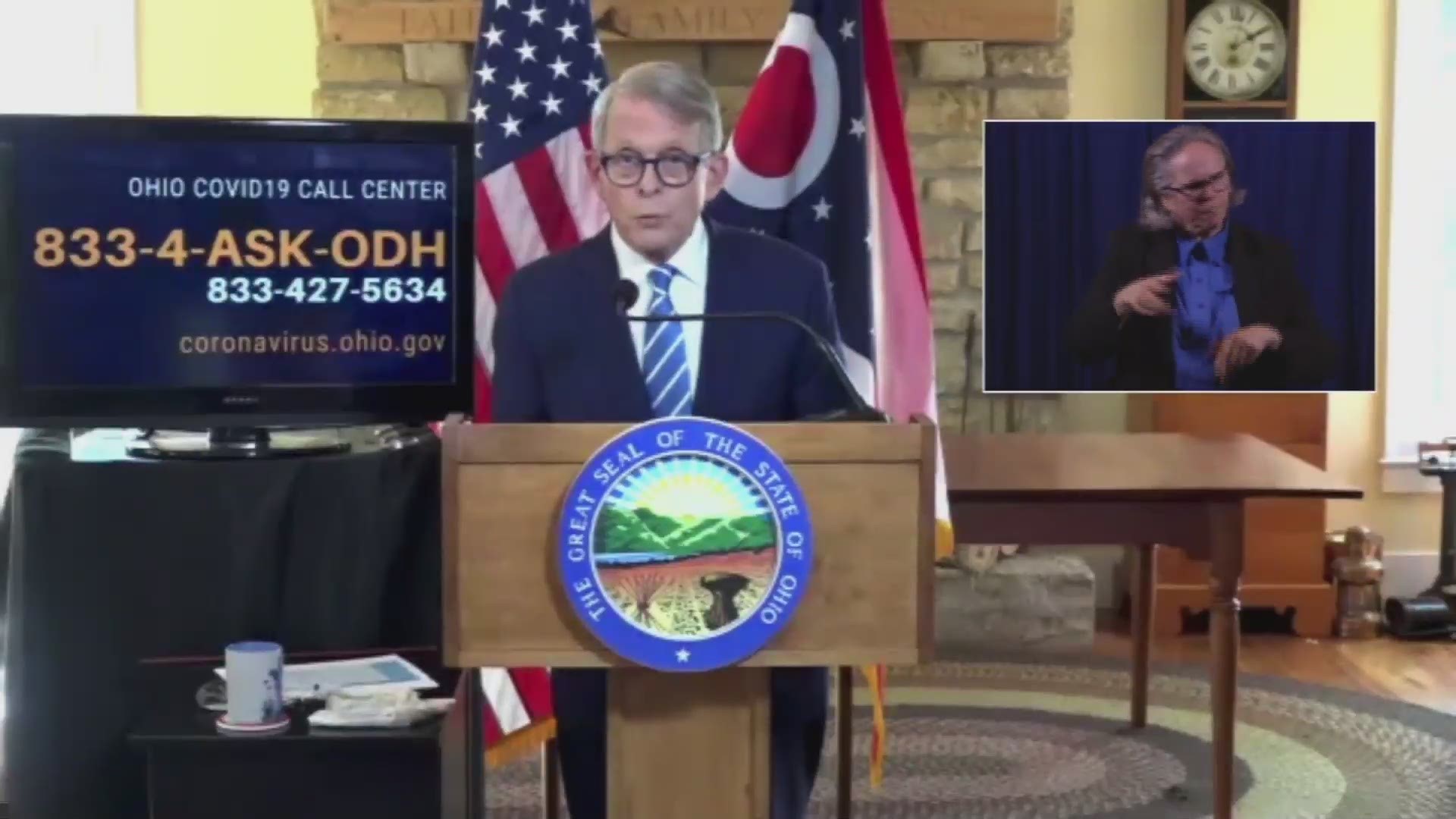COLUMBUS, Ohio — Ohio continued to break records Thursday, with the highest daily increase in COVID-19 cases and second-highest in hospitalizations since the pandemic began.
A number of northwest Ohio counties were added to Level 3 (Red) in the state's Public Health Advisor System, making a total of 12 for the region.
Despite the rising numbers, Ohio Gov. Mike DeWine expressed optimism as the country nears the development of a vaccine. However, he said that there is still work to be done to mitigate potential damage done in the meantime.
"We're going to get through this. There is light at the end. We can see the spring coming we can see the sun coming up. We're just not there yet and we've got to get there," DeWine said.
The governor addressed Ohioans directly Wednesday, during which he issued a new order impacting open congregate areas like banquet halls, added onto the current mask order and warned that restaurants and gyms could close should numbers continue to rise.
DeWine acknowledged Thursday that those announcements may not be well-received, but said that he believes he is doing what is necessary.
"We'd be irresponsible at this point not to take actions," DeWine said.
The governor said that while his administration doesn't want to close a single business, medical experts have told him that the state can't continue on its current path.
"We don't want to close anything, nothing; but the buck does stop with me. And I can tell you, medical experts have told me and hospitals have told me, at the rate we're going it is not sustainable. We are going to have very bad consequences if it continues going at the rate it's going," he said.
KEY METRICS
On Thursday, the Ohio Department of Health reported:
- 7,101 new cases of coronavirus compared to the 21-day average of 4,001
- 35 deaths compared to the 21-day average of 24
- 268 hospitalizations compared to the 21-day average of 185
- 21 ICU admissions compared to the 21-day average of 23

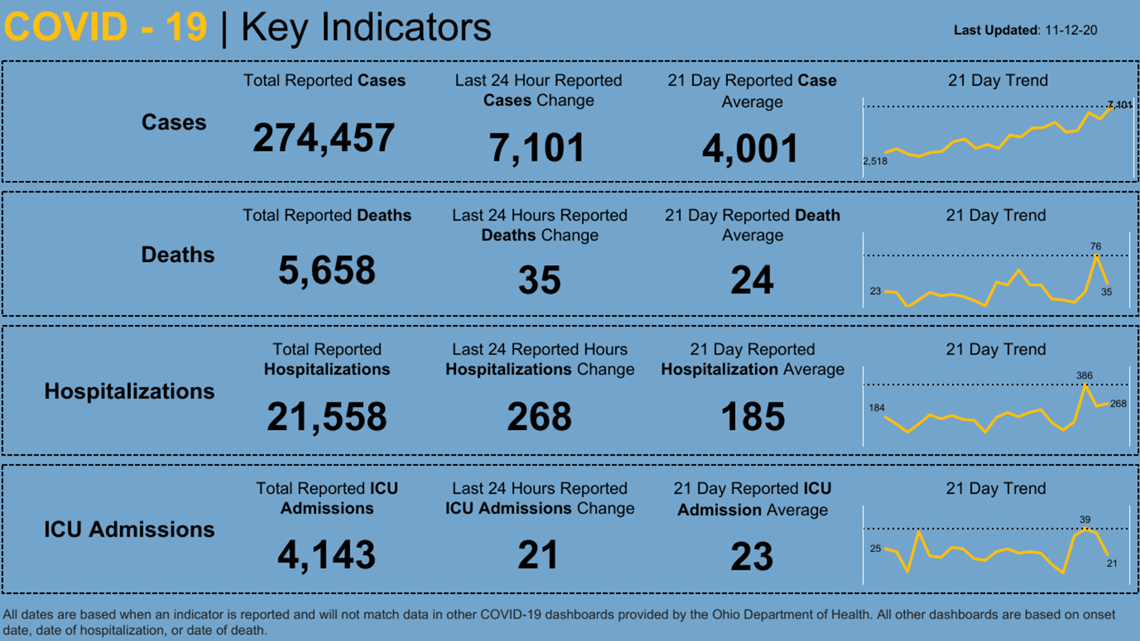
Thursday brought the highest daily increase in COVID-19 cases since the pandemic began, with 7,101. The previous record was just set on Tuesday, with 6,508 cases in a 24-hour period.
Hospitalizations came in with the second-highest 24-hour increase Thursday with 268.
The following graph shows the seven-day moving average for outpatient visits in patients with either a confirmed or suspected COVID-19 diagnosis code. DeWine said this trend is similar to those seen in case counts and hospitalizations.

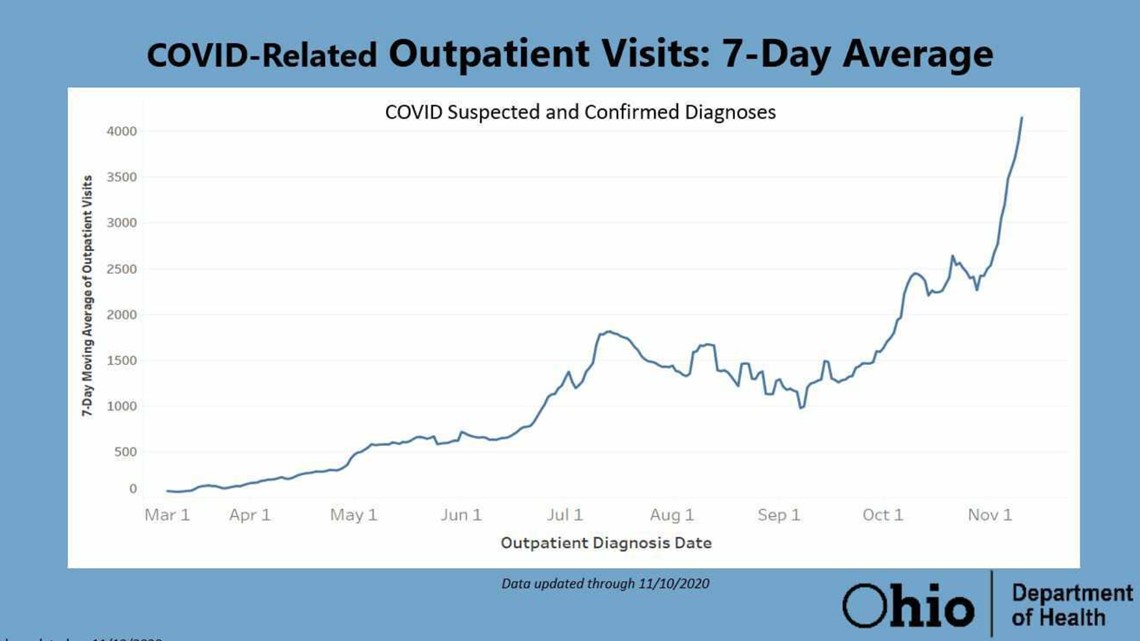
He said the state is currently at its highest point for both hospitalized and ICU patients since the onset of the pandemic.

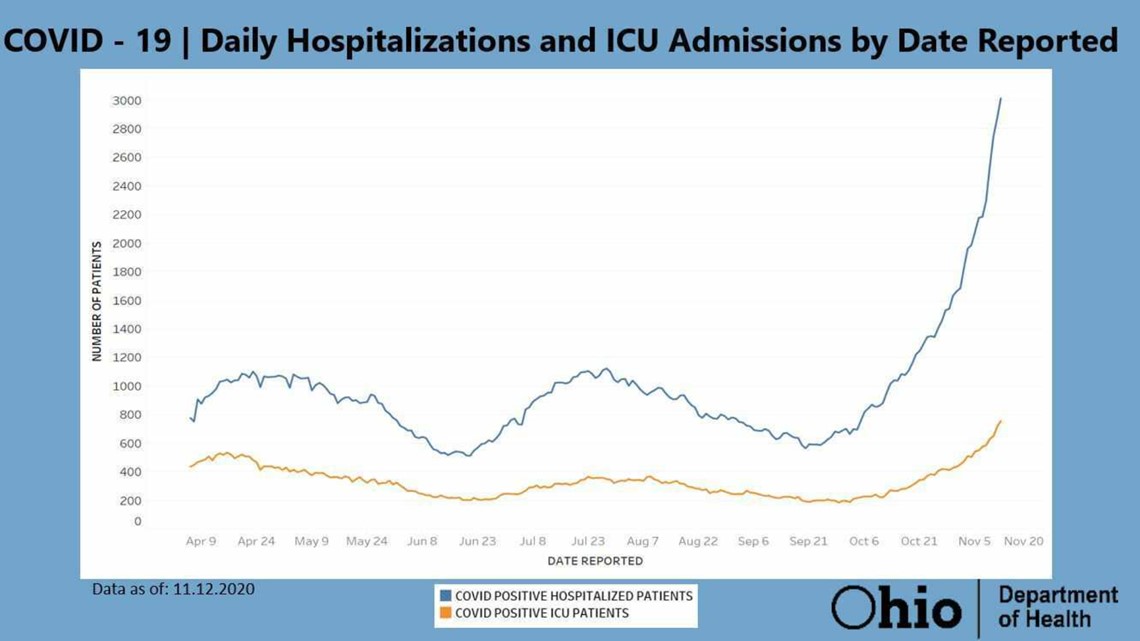
DeWine noted, again that there is a common line of thinking, where people say the increase in cases is due solely to an increase in testing. He refuted that, pointing that the rate of increase in cases is nearly four times greater than that of the increase in testing.

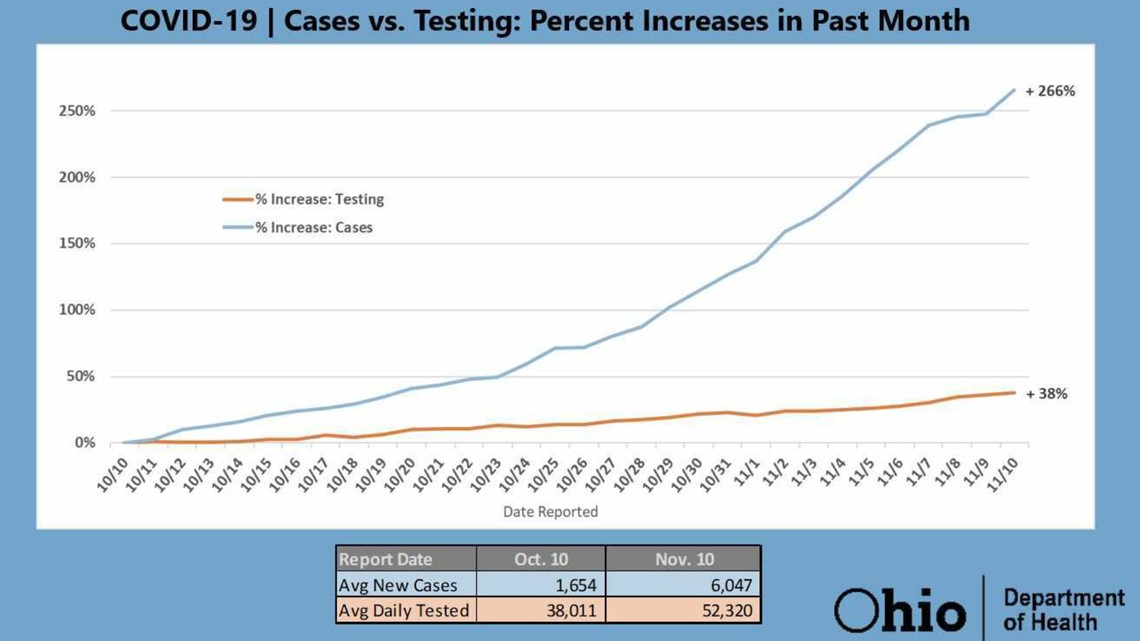
Hospitals have been a key concern for state leaders in recent weeks, as many begin to inch toward capacity. However, the strain is not on bed space. Rather, the focus is on healthcare workers as many are getting sick or are stuck in quarantine after being exposed to the virus in the communities they live in.
CASES PER 100,000
All 88 of Ohio's counties currently meet the threshold for "high incidence" per the Centers for Disease Control and Prevention (CDC), which is 100 cases per 100,000. Even the lowest county, DeWine said, is almost two times greater than the high incidence level.
For months, DeWine has released daily lists, ranking the counties in order of those with the most cases per 100,000 people to the least. Putnam County has stayed steady at the top of the list for weeks.

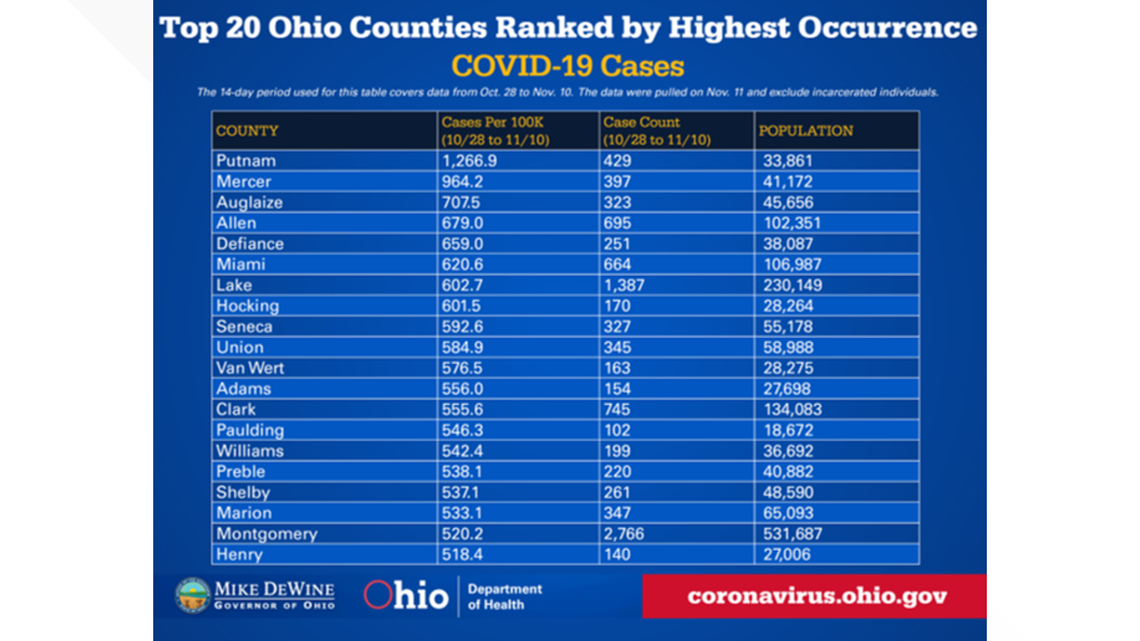
On Thursday, Putnam was reported to have 1,266.9 cases per 100,000, more than 12 times the CDC threshold.
In northwest Ohio, Defiance, Seneca, Paulding, Williams and Henry all made the top 20, all exceeding the threshold by five times or more.
PUBLIC HEALTH ADVISORY MAP
DeWine reported Thursday that 68 of the state's 88 counties had reached Level 3 (Red) on the Public Health Advisory map. Twelve of those were in northwest Ohio, including:
- Lucas
- Wood
- Defiance
- Erie
- Hancock
- Henry
- Ottawa
- Paulding
- Putnam
- Sandusky
- Seneca
- Williams

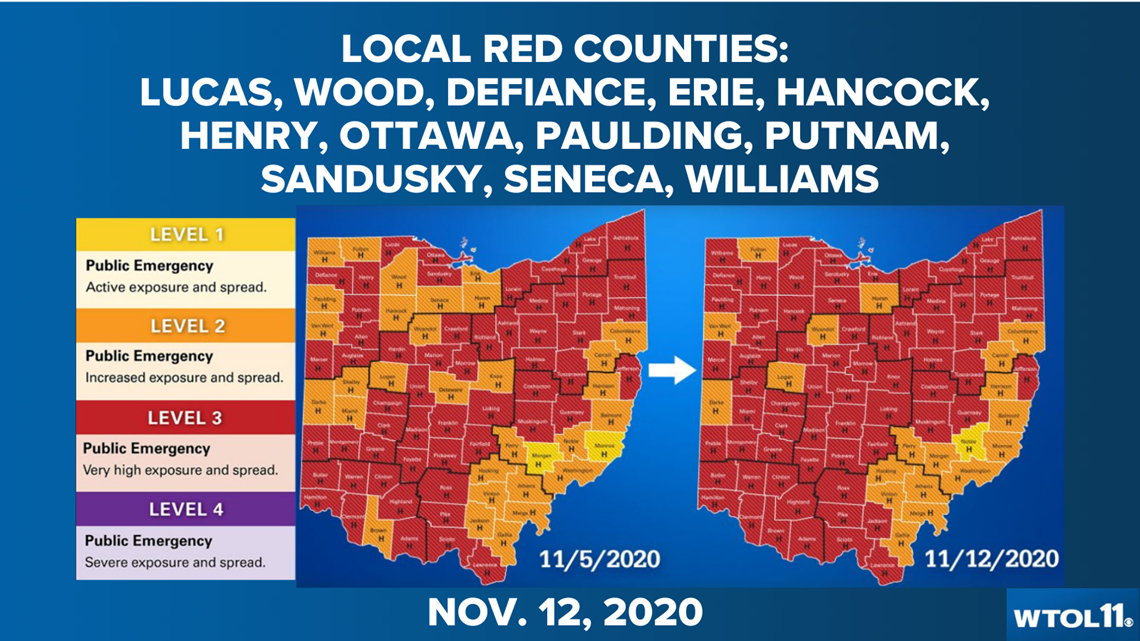
Of those, Erie, Hancock, Paulding, Seneca and Wood were new additions Thursday.
ZIP CODE AND FLU DASHBOARDS
In an effort to be more transparent, DeWine announced the addition of two new dashboards the state's coronavirus website: one for COVID-19 data by zip code and one for data regarding the flu.
ZIP CODE DASHBOARD
DeWine explained that users will soon be able to view data from their local communities on a map and filter the inforamtion by probable or confirmed case status, county, a specific zip code or within a specific time frame.
Case counts will also be available on a downloadable filterable chart, he said, sorted from the highest cases to the least. To protect confidentiality, case counts for zip codes with fewer than five cases or less than 100 total residents won't be shown.
The dashboard will be available online here.
A new flu dashboard was also created that will expand the statewide seasonal flu activity reported by the Ohio Department of Health (ODH) each year, showing trends overtime with charts that indicate whether or not hospitalizations or flu-like illnesses are on the rise.
Data will be broken down by region, county, date, sex, age, race and ethnicity and will only show positive flu PCR tests reported by public health laboratories.
That dashboard can be found online here.
COUNTY HEALTH DEPARTMENT FUNDING
DeWine announced that his team will be setting aside $30 million to assist the state’s 113 local health departments. Each department will receive $200,000 and they will have the flexibility to determine how to best use the funds as they see fit to fight COVID-19.
The remaining funds will be used to hire contact tracers to support local health departments. Those tracers would be able to deploy wherever they are needed across the state to assist in identifying individuals who may have been exposed to COVID-19 and prevent further spread.
"As we have throughout this pandemic, we will continue to offer state resources and support to help fight COVID-19 at the local level," DeWine said.
Watch the full press conference below:
WEDNESDAY'S ADDRESS
In the middle of another record-breaking week in Ohio's fight against the coronavirus, Gov. Mike DeWine issued new orders regarding retail stores and open congregate areas, noting that more could be on the horizon should the situation continue on its current trajectory.
"We are at the most crucial phase in the pandemic," DeWine said.
DeWine spoke to Ohioans directly in a primetime address Wednesday night, starting off on an optimistic note, following Monday's news of the progress being made on a potential vaccine by pharmaceutical company Pfizer. He said the state is ready to distribute a vaccine when one is approved and available, explaining first responders and vulnerable populations will be top priority.
However, the main focus of Wednesday's address was on what the governor believes needs to be done in the meantime to prevent the virus from spreading even further into our communities. While the governor continued to echo his refrain of "personal responsibility," he did announce a new order on the way regarding open congregate areas and doubled down on orders already in effect.
OPEN CONGREGATE AREAS
The governor said the new order impacting open congregate areas, like banquet halls, would be signed later this week. While the specifics were not announced Wednesday, DeWine said that restrictions would be "significant," noting that everyone would need to be seated and masked unless actively consuming food or drink and that no dancing or games would be allowed in those spaces.
The governor reminded Ohioans that the state's limit on gatherings of more than 10 people was still in effect. He said that despite this order, they have seen rampant spread as a result of banquets, weddings and funerals, saying that it isn't happening during the ceremonies, rather, at the parties afterward.
MASK ORDER
DeWine reissued the state's mask order during his evening address, adding on new requirements that impact businesses.
He said that every retail employee has the right to feel safe so each customer must be wearing a mask, and vice versa.
Here are the new additions to the current order:
- Each business will be required to post a face-covering requirement sign at entrances.
- The store is responsible for making sure customers and workers are wearing masks.
- A new "Retail Compliance Unit," comprised of Bureau of Workers Compensation employees will work to ensure businesses are complying.
For a business's first violation, they will receive a written warning. However, a second violation could close its doors for up to 24 hours.
BARS, RESTAURANTS AND FITNESS CENTERS
DeWine said that the state's bars, restaurants and fitness centers could remain open for now, but should the virus continue on its current path, they may be forced to close.
He said that on Thursday of next week, his team will evaluate the situation and make a decision from there.
During this Thursday's press conference, DeWine clarified that they will be guided by what hospitals are telling them and reminded Ohioans that no decision on this has been announced just yet.
DeWine said that he understood the burden a second closure would place on business owners and employees, but noted that restaurants and gyms are unique to other indoor activities due the how long people spend in these facilities and the length of time spent there without a mask.
SCHOOLS
The governor praised leaders at K-12 schools for the work they've done to ensure student safety. He also said that he believes most children are better off learning in school as opposed to a virtual environment.
However, he did address the fact that the increasing surge has held some teachers back from the classroom, and is causing some schools to make the shift back to remote learning. He called on everyone in the state to be diligent in their mask use to keep students in school through the winter.
"We must do everything in our power to slow this virus down so our kids can stay in school. It is up to each and every one of us," DeWine said.
COLLEGES AND UNIVERSITIES
DeWine issued a "thank you" to leaders of Ohio colleges and universities for the decision many of them made to not return after Thanksgiving break, and to instead finish the semester virtually.
However, he said that unless spread of the virus was dramatically slowed, institutions of higher education may need to stay online as the following semesters picks up in January.
DATA
DeWine's message to the state came amid record-setting coronavirus numbers in the state of Ohio.
"This surge is much more intense, widespread and dangerous," DeWine said compared to the previous two waves to hit the state.
In Sept., Ohio was averaging less than 1,000 new cases a day. On Wednesday, the state had its second-highest daily increase with 5,874. The record set just the day before with 6,508. On Thursday, it was revealed this record was broken yet again.
DeWine acknowledged that some people believe the sole reason the state has reported more cases is because of the increase in testing. The governor said that while the state has greatly increased testing, it hasn't even doubled. But, when you look at cases, those have nearly quadrupled.
HOSPITALS
DeWine said that during the spring and summer surges, the most people in the hospital at one time was just over 1,100. Last week, that number was almost 2,000 and on Wednesday, that number was approaching 3,000.
There are now a record number of people in the ICU as DeWine mentioned that last month, there were 240 patients compared to the current number of 700.
In the first week of Nov., 104 Ohioans died from COVID-19.
"To those families, please know that Ohio grieves with you," DeWine said.
On Monday, DeWine brought together several health leaders including his incoming Ohio Department of Health Chief Medical Officer, Dr. Bruce Vanderhoff, for a briefing with the media. The message was that coronavirus cases are continuing to spike at an alarming rate, running the risk of stretching thin the state's medical staff.
However, the concern doesn't lie in a lack of material resources, such as beds or personal protective equipment, as was discussed at the onset of the pandemic. As coronavirus cases continue to increase throughout the state of Ohio, it is becoming increasingly difficult to protect hospital staff. Health leaders said that hospital employees are generally not getting sick at work. They are contracting the virus, or are being exposed, while in the community.
The state health department's new chief medical officer, Dr. Bruce Vanderhoff, said that hospitals statewide reaching maximum capacity because of their exhausted supply of trained personnel. He explained that these workers can't escape the impact of COVID-19 in their personal lives and when they have to quarantine, they can't be bedside.
You can watch Monday's briefing in the player below:

